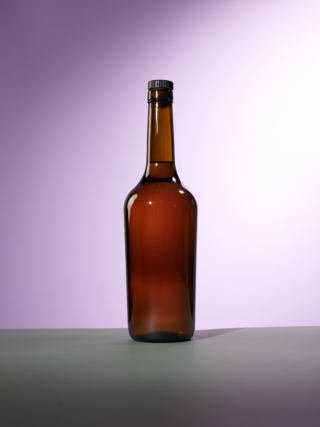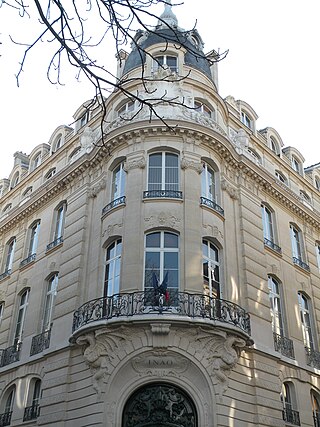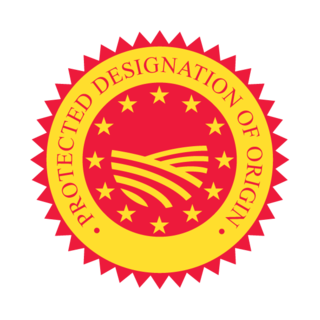
Calvados is a brandy from Normandy in France, made from apples and/or pears.
An appellation is a legally defined and protected geographical indication primarily used to identify where the grapes for a wine were grown, although other types of food often have appellations as well. Restrictions other than geographical boundaries, such as what grapes may be grown, maximum grape yields, alcohol level, and other quality factors may also apply before an appellation name may legally appear on a wine bottle label. The rules that govern appellations are dependent on the country in which the wine was produced.

Three European Union schemes of geographical indications and traditional specialties, known as protected designation of origin (PDO), protected geographical indication (PGI), and traditional speciality guaranteed (TSG), promote and protect names of agricultural products and foodstuffs, wines and spirits. Products registered under one of the three schemes may be marked with the logo for that scheme to help identify those products. The schemes are based on the legal framework provided by the EU Regulation No 1151/2012 of the European Parliament and of the Council of 21 November 2012 on quality schemes for agricultural products and foodstuffs. This regulation applies within the EU as well as in Northern Ireland. Protection of the registered products is gradually expanded internationally via bilateral agreements between the EU and non-EU countries. It ensures that only products genuinely originating in that region are allowed to be identified as such in commerce. The legislation first came into force in 1992. The purpose of the law is to protect the reputation of the regional foods, promote rural and agricultural activity, help producers obtain a premium price for their authentic products, and eliminate the unfair competition and misleading of consumers by non-genuine products, which may be of inferior quality or of a different flavour. Critics argue that many of the names, sought for protection by the EU, have become commonplace in trade and should not be protected.

The following four classifications of wine constitute the Italian system of labelling and legally protecting Italian wine:
In Spain and Latin America, the denominación de origen is part of a regulatory geographical indication system used primarily for foodstuffs such as cheeses, condiments, honey, and meats, among others. In wines, it parallels the hierarchical systems of France (1935) and Italy (1963), although Rioja (1925) and Jerez (1933) preceded the full system. In foods, it performs a similar role, regulation of quality and geographical origin of products from Spain. There are five other designated categories solely for wine and a further three specifically covering food and condiments, all recognised by the European Union (EU). In Catalonia, two further categories – labelled A and Q – cover traditional Catalan artisan food products, but were not recognised by the EU as of 2007. In recent decades, the concept of the denominación de origen has been adopted by other countries, primarily in Latin America. In 2016, the use of the Denominación de Origen (DO) for wines was registered as a European Union Protected Designations of Origin/Denominación de Origen Protegida (PDO/DOP), but the traditional Portuguese term of DO can still be used legally on labels.

In France, the appellation d'origine contrôlée is a label that identifies an agricultural product whose stages of production and processing are carried out in a defined geographical area – the terroir – and using recognized and traditional know-how. The specificity of an AOC product is determined by the combination of a physical and biological environment with established production techniques transmitted within a human community. Together, these give the product its distinctive qualities.

Vin de pays was a French wine classification that was above the vin de table classification, but below the appellation d'origine contrôlée (AOC) classification and below the former vin délimité de qualité supérieure classification. The vin de pays classification was replaced by the EU indication Indication Géographique Protégée in 2009.
Table wine is a wine term with two different meanings: a style of wine and a quality level within wine classification.

Bugey wine is produced in the Bugey region in the Ain département of France, under the two VDQS designations Bugey and Roussette du Bugey. On May 28, 2009, INAO gave its final approval for the elevation of Bugey and Roussette du Bugey to Appellation d'origine contrôlée (AOC) status.

The Institut national de l'origine et de la qualité (INAO) is the French organization charged with regulating French agricultural products with protected designation of origin (PDOs). It is controlled by the Government of France, and it forms part of the Ministry of Agriculture. The organization was co-founded by Châteauneuf-du-Pape producer Baron Pierre Le Roy.

French wine is produced throughout all of France in quantities between 50 and 60 million hectolitres per year, or 7–8 billion bottles. France is one of the largest wine producers in the world. French wine traces its history to the 6th century BCE, with many of France's regions dating their wine-making history to Roman times. The wines produced range from expensive wines sold internationally to modest wines usually only seen within France such as the Margnat wines of the post-war period.

The mainstream quality wine regions in Spain are referred to as denominaciones de origen protegidas (DOP) and the wine they produce is regulated for quality according to specific laws, and in compliance with European Commission Regulation (CE) 753/2002. In 2016, the use of the term Denominación de Origen (DO) was updated to Denominación de Origen Protegida (DOP) by the Spanish Ministry of Agriculture, Fisheries and Food ; the traditional term of DO can still be used legally on labels, but it will eventually be replaced by DOP.
The denominação de origem controlada is the system of protected designation of origin for fruit, wines, cheeses, butters, and other agricultural products from Portugal.
European Union wine growing zones are used in the common European Union wine regulations to regulate certain aspects of winemaking. The zones differ in terms of climate and examples of what is regulated by wine growing zone are required grape maturity at harvest and allowed levels of chaptalisation. There are 21 wine producing countries in the European Union, with 14 of them having significant levels of production. In the 2004-2005 vintage, total European Union wine production was around 184 million hectoliters which accounted for nearly 70% of total worldwide production. Of that total, nearly 55% was classified as table wine with 4% used in the production of grape-based distilled spirits such as Armagnac and Cognac.
Wine laws are legislation regulating various aspects of production and sales of wine. The purpose of wine laws includes combating wine fraud, by means of regulated protected designations of origin, labelling practices and classification of wine, as well as regulating allowed additives and procedures in winemaking and viticulture. Legislation affecting all kinds of alcohol beverages, such as the legal drinking age and licensing practices related to distribution and sales, are usually not considered wine laws.
European Union wine regulations are common legislation related to wine existing within the European Union (EU), the member states of which account for almost two-thirds of the world's wine production. These regulations form a part of the Common Agricultural Policy (CAP) of EU, and regulate such things as the maximum vineyard surface allowed to individual EU member states, allowed winemaking practices and principles for wine classification and labelling. The wine regulations exist to regulate total production in order to combat overproduction of wine and to provide an underpinning to Protected designations of origin (PDOs), among other things. In a sense, the wine regulations therefore try to protect both the producer and the consumer.

The Saint-Chinian is a French wine, from the Languedoc-Roussillon wine region of France. It is usually a blend of several grape varieties, and produced in red, rosé, and white versions. Since 1982, the name is protected by an appellation d'origine contrôlée. Its terroir was named after the nearby village of Saint-Chinian.

In Switzerland, the appellation d'origine protégée is a geographical indication protecting the origin and the quality of traditional food products other than wines.

The protected designation of origin (PDO) is a type of geographical indication of the European Union aimed at preserving the designations of origin of food-related products. The designation was created in 1992 and its main purpose is to designate products that have been produced, processed and developed in a specific geographical area, using the recognized know-how of local producers and ingredients from the region concerned.












